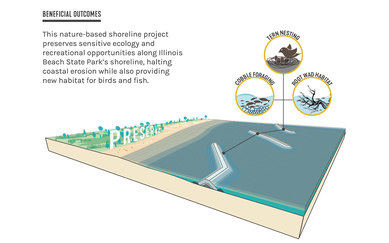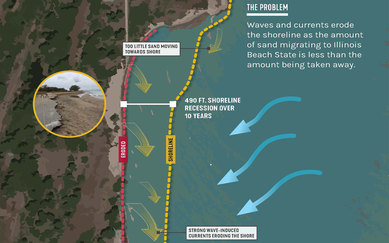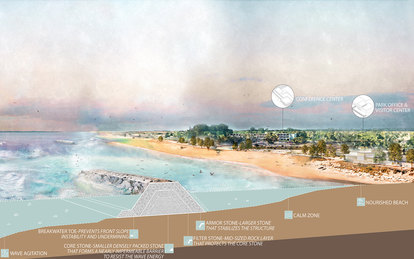Illinois Beach State Park Shoreline Protection
Offshore structures control severe erosion along a 6-mile stretch of Lake Michigan shoreline, while retaining its undeveloped nature and preserving rare habitat.
Client
State of Illinois Capital Development Board
Location
Zion, Illinois
Markets/Services
Civil Engineering, Coastal Engineering, Energy & Environmental Modeling, Green Infrastructure, Greenways & Trails, Landscape Architecture, Natural Systems & Habitats, Parks & Open Spaces, Public Spaces, Shoreline Protection & Restoration, Waterfront
Size
6 Miles
Fifty miles north of Chicago, Illinois Beach State Park represents the last remaining undeveloped Lake Michigan shoreline in the state of Illinois. The park features rare panne wetlands, nature preserves, hiking/biking trails, fishing access, campsites and other recreational amenities enjoyed by 1.25 million visitors per year.
Yet the park’s entire shoreline was under threat. Portions of the state park were eroding away at a rate of more than 100 feet a year, and during storms it would sometimes lose more than 10 feet in a single day. The Illinois Department of Natural Resources turned to SmithGroup to study the shoreline and develop concepts for stabilization in a way that would also retain the park’s natural habitat areas.

Rather than building protective structures on the shoreline, offshore structures work with the natural forces of Lake Michigan, modifying the nearshore waves and currents to slow longshore sand movement and reduce coastal erosion.
Before marinas, river dams and other human impacts altered coastal processes and sand sources, the beach ridge would naturally migrate, moving and redistributing sand and sediment. SmithGroup’s engineering solution places submerged breakwaters offshore to simulate this dynamic natural littoral transport process. The submerged breakwaters balance sand coming into and leaving the site, restoring a more resilient, functioning shoreline that reduces beach erosion, continues to slowly feed down-coast areas, and retains the critical land/water interface needed to protect the park’s pristine habitats.

Working cooperatively with Illinois Department of Natural Resources and the U.S. Army Corps of Engineers, the team developed its concept designs following substantial technical analysis and physically testing scale models of the concepts in a modeling lab. That informed the location, shape and size of a series of offshore breakwaters—engineered to work cohesively as one system—in the areas experiencing the greatest erosion.
Once the concept designs were approved, it was critical to move forward as quickly as possible to prevent further shoreline losses. By preparing bridging documents for a design-build contract, the SmithGroup design and engineering team was able to secure project permits and expedite contractor selection, shaving approximately one year off the construction schedule. The successful effort marks the first time a coastal protection and restoration project has been handled as a design-build in the state of Illinois.
